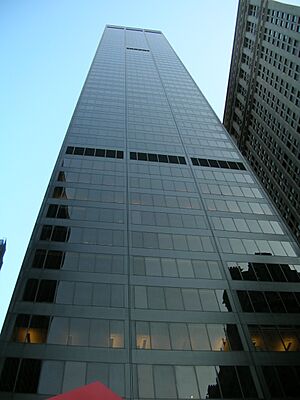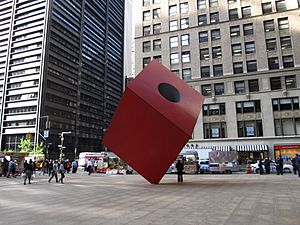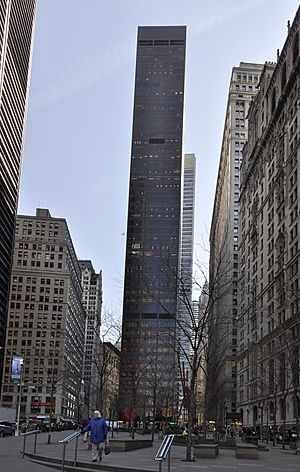140 Broadway facts for kids
Quick facts for kids 140 Broadway |
|
|---|---|

The western facade viewed from the ground
|
|
| Alternative names |
|
| General information | |
| Status | Complete |
| Architectural style | International Style |
| Location | 140 Broadway New York City 10005 United States |
| Coordinates | 40°42′31″N 74°00′36″W / 40.70861°N 74.01000°W |
| Construction started | 1964 |
| Completed | 1967 |
| Owner | Union Investment |
| Height | |
| Roof | 688 ft (210 m) |
| Technical details | |
| Floor count | 52 |
| Floor area | 111,805 m2 (1,203,460 sq ft) |
| Design and construction | |
| Architect | Gordon Bunshaft (Skidmore, Owings and Merrill) |
| Structural engineer | James Ruderman |
| Designated | June 25, 2013 |
| Reference no. | 2530 |
140 Broadway is a tall, 51-story office building in New York City. It's located in the Financial District of Manhattan, right on Broadway. People also used to call it the Marine Midland Building or the HSBC Bank Building.
This building was designed by Gordon Bunshaft from the famous architecture firm Skidmore, Owings & Merrill. It has a sleek, black outside and stands on a plot of land shaped like a trapezoid. The building is about 688 feet (210 meters) tall. One of its most famous features is a bright red sculpture at its entrance called Cube, created by Isamu Noguchi.
The land for 140 Broadway was bought between 1952 and 1961. The building itself was constructed from late 1964 to 1967. Its first main tenant was the Marine Midland Bank, which later became part of HSBC. Many early businesses in the building were related to money, like banks and accounting firms. In 1998, the building was sold to Silverstein Properties, which gave it a big makeover.
Since 2002, the main company in the building has been Brown Brothers Harriman. This happened after HSBC moved out in 2001. A company called Union Investment has owned the building since 2004. In 2013, the New York City Landmarks Preservation Commission officially named 140 Broadway a city landmark. Many architecture experts have liked the building, especially its smooth black look.
Contents
Location and Shape
140 Broadway takes up an entire city block in the Financial District. It's bordered by Broadway to the west, Liberty Street to the north, Nassau Street to the east, and Cedar Street to the south.
The block isn't a perfect rectangle; it's shaped like a trapezoid, which means all its sides are different lengths. The building itself only covers about two-fifths of this block. Its base is also a unique rhomboid shape, matching the unusual shape of the land. Even some people who worked in the building didn't realize its "funny shape."
Nearby buildings include One Liberty Plaza, the Federal Reserve Bank of New York Building, and 28 Liberty Street. Trinity Church and Wall Street are also just two blocks away.
Building Design
The design of 140 Broadway followed the International Style. This style is known for its simple, clean lines and often uses glass and steel. The building was constructed by the Diesel Construction Company. Gordon Bunshaft was the main architect, and James Ruderman was the engineer who made sure the structure was strong.
140 Broadway has 51 stories and stands about 688 feet (210 meters) tall. Each floor is quite large, and the whole building has about 1.2 million square feet of space. The building is also very energy efficient. It has even received a Gold certification for Leadership in Energy and Environmental Design, which means it's a "green" building.
Look and Outside Walls
In 1961, New York City changed its building rules. The new rules allowed skyscrapers to be very wide and tall if they also included open spaces at ground level. 140 Broadway was designed to fit these new rules perfectly.
The building's developer wanted to make the building look very tall. So, the designers highlighted the vertical tracks used for window washing on the outside. The rest of the building's outside walls, or "facade," are very smooth. They are made of black aluminum and glass panels.
The western side of the building has three sections of six windows each. The eastern side has four sections, and the north and south sides each have seven sections of six windows. The only other things on the outside are the number "140" and the old "Marine Midland Bank" name. There are many spinning doors on all sides for people to enter.
Public Plaza
140 Broadway is set back from the streets, creating a public plaza around it. This open space is covered with white tiles. There used to be an entrance to the New York City Subway's Broad Street station on the plaza, but it was removed. There's also a granite monument to Harry Helmsley, one of the developers, in the plaza.
The Cube Sculpture
The famous red sculpture called The Cube was added to the plaza in 1968. The architect, Gordon Bunshaft, suggested that artist Isamu Noguchi create a sculpture for the building. Noguchi first thought of a group of large stones, but that was too expensive. So, they decided on one large block instead.
The Cube is a bright red, 28-foot-tall (8.5 meters) sculpture. It's shaped like a tilted box with a round hole going through its middle. It stands on one corner, making it look unique. The sculpture is placed off-center in the plaza, on the north side. Its bright red color stands out against the building's dark facade. Both the architect and art critics loved how The Cube looked with the building.
Building History
How it was Built
In 1952, a developer named Erwin S. Wolfson started buying up the land where 140 Broadway now stands. There were already several buildings on the block, owned by different companies. By 1961, Wolfson owned all the plots. He first planned a 32-story building. In 1961, Skidmore, Owings & Merrill (SOM) was hired to design it.
Wolfson passed away in 1962. Another developer, Harry Helmsley, took over the project. The plans changed several times. By 1964, they decided on a 49-story building that would take up two-fifths of the block.
Demolition of the old buildings began in June 1964. The builders tried to keep noise down by working during off-peak hours and using heavy blankets to muffle sounds. The construction of the building itself was also quiet, using a special "butt-welded" steel frame that needed less noisy bolting and riveting. One floor was built every two days! The building was finished, or "topped out," in June 1966. People working nearby said the construction was quieter than a lawnmower.
What it was Used For
In 1965, Marine Midland Bank rented the first 20 floors and the basements. Because they were the biggest tenant, the building was named the Marine Midland Building. The bank's main hall was on the second floor. By 1967, 90% of the building was rented, and it was officially completed in October of that year. Other early tenants included financial firms and even the government of Puerto Rico. In 1980, HSBC took over Marine Midland Corporation.
After Harry Helmsley died in 1997, his wife, Leona Helmsley, sold many of his properties. 140 Broadway was very popular with buyers, even though it needed renovations. In 1998, Larry Silverstein's company, Silverstein Properties, bought it for $190 million. Silverstein spent $60 million to renovate the building.
HSBC, which used to be the main tenant, moved its headquarters in 2001. Then, Brown Brothers Harriman & Co. became the new main tenant, moving into 20 floors. In 2004, a German company called Union Investment bought the building.
On June 25, 2013, the New York City Landmarks Preservation Commission officially made 140 Broadway a New York City Landmark. In 2018, the building's owners planned to add new planters and seating to the plaza. Even though there was some discussion about these changes, the Landmarks Preservation Commission approved them.
Images for kids
-
Seen from Liberty Street and Broadway; 140 Broadway is located behind the plaza containing The Cube. The Equitable Building is at right
See also
 In Spanish: 140 Broadway para niños
In Spanish: 140 Broadway para niños





